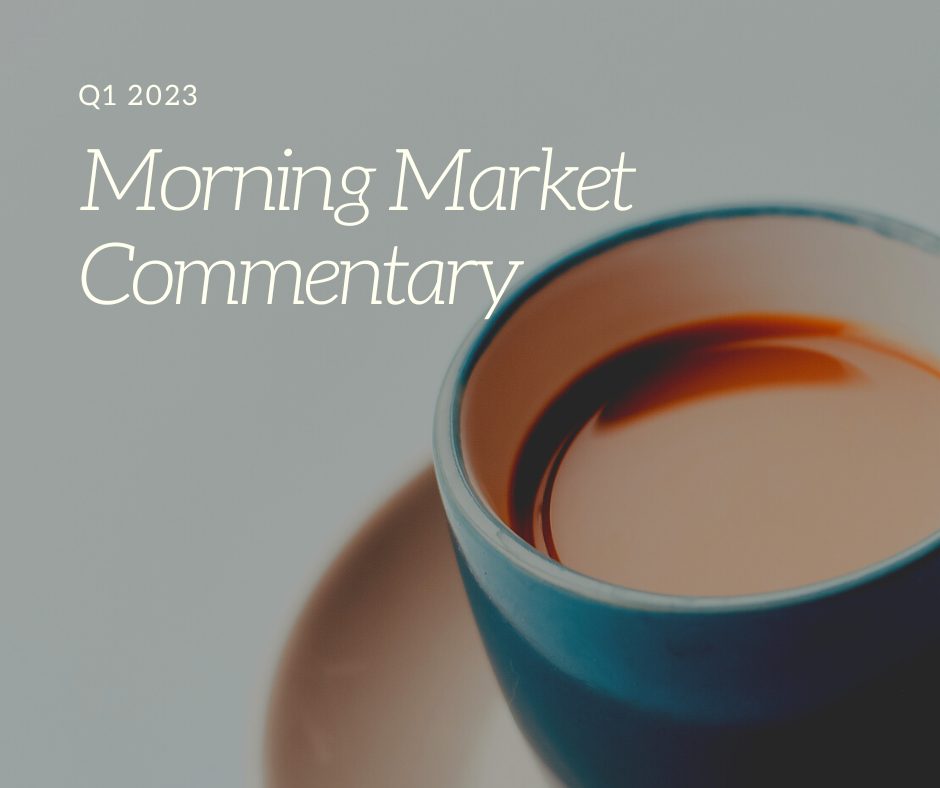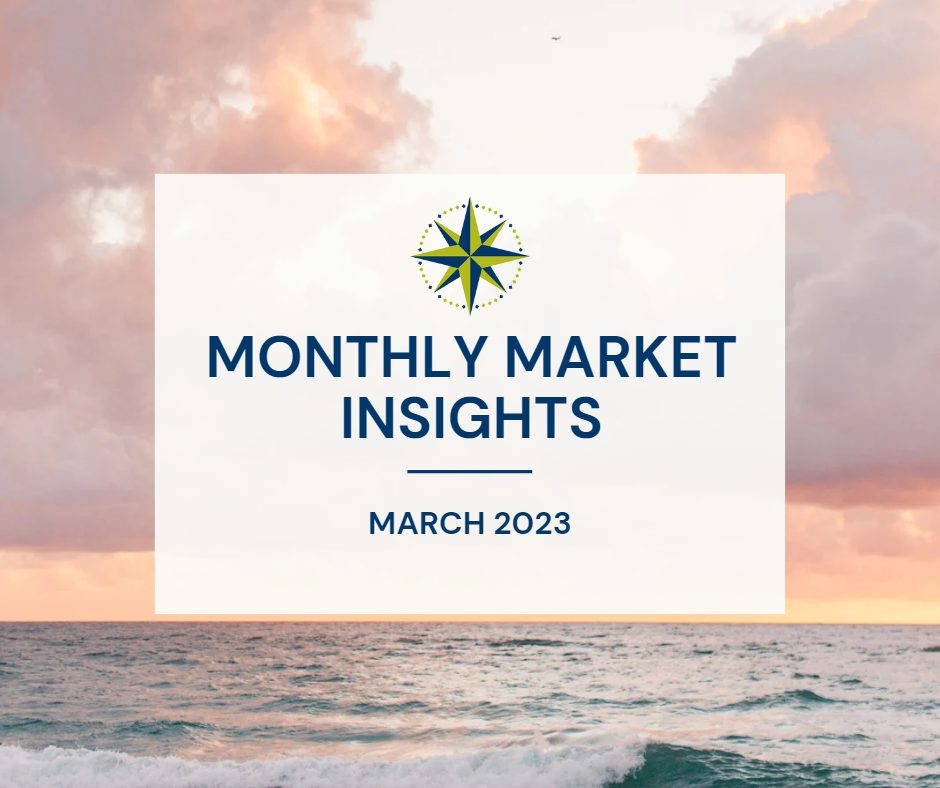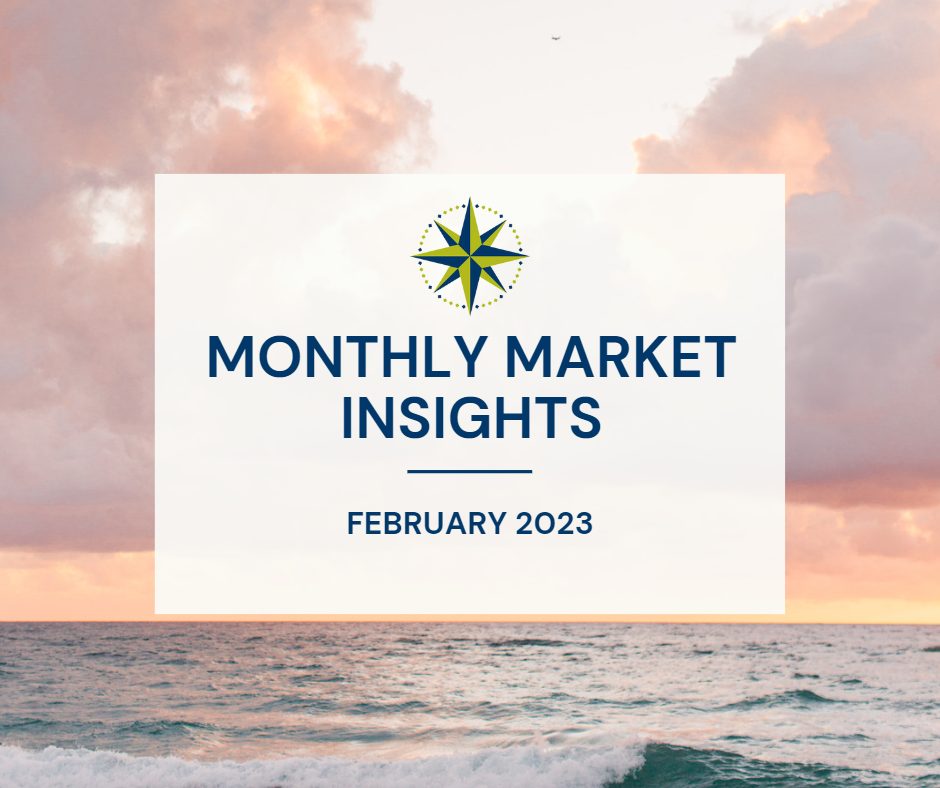During the first quarter of 2023 sentiment started off hot with great gains in January…

Monthly Market Insights | May 2023
US Markets
Stock overcame recession worries and mixed corporate earnings results in April, ending mostly higher.
For the month, the Dow Jones Industrial Average picked up 2.48%, whereas the Standard and Poor’s 500 Index rose 1.46%. The Nasdaq Composite which was up nearly 17% in the first quarter of 2023, was flat 0.04% in April.
Recession Watch
While the start of the year revolved around the direction of Fed monetary policy, investors in April began to turn their focus toward the economic impact of the Fed’s year-long series of steep rate hikes.
Throughout the month, growing fears of a recession were bolstered by weak economic data, ongoing softness in the housing market and another monthly decline in leading economic indicators.
Inflation Update
Inflation was a bright spot, however. Consumer prices continued to decrease in a meaningful way, while producer prices, a potential indicator of future consumer prices, also fell, providing some positive relief to investors. Nevertheless, inflation remained above the Fed’s target rate of 2% and many are worried that inflation may remain sticky at these elevated levels.
Earnings Update
The first-quarter earnings season commenced in April with much foreboding. Earnings estimates had been cut in the preceding months as Wall Street analysts considered a slowing economy and waning consumer strength. So far, the results have not confirmed the worst fears of investors, but there has been little to excite investors.
Through April 28th, with 53% of the companies comprising the S&P 500 Index reporting, 79% reported profits above estimates. This is slightly above the five-year average of 77%. In total, 20 S&P companies issued positive guidance, while twenty-eight delivered a negative outlook. Despite these mixed results, the first quarter is off to a better start than the previous two quarters.
Mega-Cap Tech Names
Positive earnings results from several mega-cap technology companies ignited strong gains in the closing days of the final week of trading, solidifying the month’s gains.
Sector Scorecard
All but one sector rallied in April, led by Communication Services (+3.72%) mainly driven by positive earnings reports by Mega-Cap names, Consumer Staples (+3.68%) mainly driven by increased recession fears and Health Care (+2.89%) mainly driven by positive earnings. Meanwhile, Industrials (-1.52%), even with the sector forecasting around 11% growth this year. In the below chart, we can see Industrials sector lagging the S&P significantly throughout 2023.

What Investors May Be Talking About in May
May kicked off with the conclusion of another Federal Open Market Committee (FOMC) meeting, which may set up a debate about what factors will drive the Fed’s next move with interest rates.
Investors may even seek to analyze the Fed’s reports on regional manufacturing activity to gauge economic health. The report’s broad indicators for activity remain negative, although the indexes for new orders and shipments have increased. Of course, some headline reports will still be watched closely, like those on retail sales and housing.
Also, expect some attention to shift to lending activity by banks, which has fallen since the regional banking credit issues surfaced in March. Should lending continue to decline, it could predict an economic slowdown as businesses and consumers lose access to credit.
World Markets
The MSCI EAFE Index gained 2.45% in April as resilient economic data outweighed a tightening monetary environment.
European markets were mostly higher, with the U.K. adding 3.13% and France tacked on 2.31%. Asia markets were also mostly higher; however, China’s Hang Seng Index fell another 2.48%.
Indicators
Gross Domestic Product (GDP)
The initial estimate was that first-quarter GDP rose at an annualized rate of 1.1%, as solid consumer spending helped offset a decline in business investment and a deceleration in nonresidential investment. Economists estimated 2% economic growth.
Employment
Employers added 236,000 workers in March, the lowest number in over two years. The unemployment rate fell to 3.5%. Wage gains continued to moderate as the three-month annualized rate of growth in hourly income (+3.2%) fell below pre-pandemic levels. This is a sign the Federal Reserve has been looking for as it seeks to combat inflation.
Retail Sales
Consumer spending at retail stores and restaurants declined by 1.0% as consumers slowed their purchasing of autos, electronics, and home and garden items. It was the second consecutive month of contracting retail sales. Another sign that the Federal Reserve wants to see in their fight to bring down inflation.
Industrial Production
Industrial production rose by 0.4% in March, driven by a surge in the utility sector as consumers used more heating in response to cold weather. The mining and manufacturing sectors both experienced declines.
Housing
Housing starts slipped by 0.8% in March, dragged lower by a 5.9% decline in multifamily dwelling starts. Single-family home construction increased by 2.7%. Permit applications to build fell by 8.8%, indicating continued softness.
Sales of existing homes slid 2.4% from February and 22.0% from March 2022 as higher mortgage rates and low inventory are impacting affordability. Current 30-Year Mortgage Rates are at 6.39%.
New home sales jumped 9.6% to reach their highest level since March 2022. The median price of March 2023 new home sales was $449,800, a 3.2% rise from last year.
The chart below shows a breakout of 30-Year Mortgage Rates over the past 3 years as well as the Median Sales Prices for New and Existing Homes.

Consumer Price Index (CPI)
The prices consumers paid for goods and services cooled in March, rising just 0.1% versus the consensus forecast of 0.2%. The year-over-year inflation rate also moderated to 5.0%, down from 6.0% in February. Decreases in food and energy, along with smaller gains in shelter costs, were the primary reasons for the lower headline inflation report.
Even though we are seeing year-over-year inflation continue to fall, the biggest concern for investors continues to be month-over-month Core PCE (Personal Consumption Expenditures) & Core CPI (Consumer Price Index) as seen below. The volatility month-over-month is a sign that inflation is not slowing at a rate the Fed would like it to be, and they continue to fight with the decision to continue to raise interest rates or pause.

Durable Goods Orders
Durable goods orders rose by 3.2% propped up by passenger plan orders.
The Fed
The minutes from the March meeting of the Federal Open Market Committee (FOMC) indicated that the Fed may raise rates at least one more time, citing continuing price pressures and labor market strength. The minutes pointed out that most officials were in favor of a 0.50% hike but the uncertainty in the banking sector impacted their decision as they only increased by 0.25%. Also, the minutes identified that the probability of a recession had increased because of the banking crisis, with a probable recession occurring sometime later in the year.
On May 3rd, the Federal Open Market Committee (FOMC) raised rates another 0.25%. Comments from Fed Chair Jerome Powell sparks assumptions that this may be the last in a historic series of interest rate hikes as he spoke to increased attention to credit and other economic risks.
ONE ADVISOR | TWICE THE ADVICETM
Do you want to learn more information about how this relates to your current financial portfolio? Give us a call at (410) 823-5442 or email [email protected].
For disclaimer, please follow our link below:
https://www.peakeadvisors.com/site/wp-content/uploads/2019/05/Compliance-Social-Media-Disclaimer.pdf



